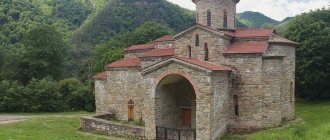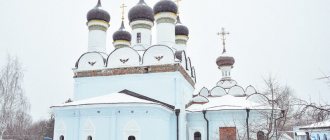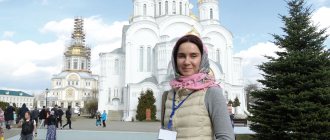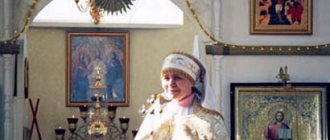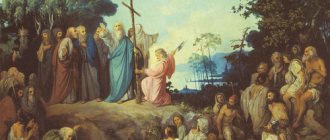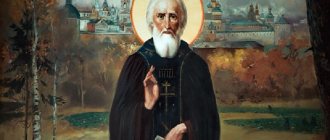HOW IT ALL BEGAN
In Maloyaroslavets there is a place to which people have come, are coming and will continue to come not only from Russia, but also from other countries of the world. Here, thanks to Abbess Nikolai, a large nunnery was revived. When Mother came in the 90s, the monastery was ruins and everything had to be started from scratch. In addition, the abbess opened a boarding school for children left without parental care. The nuns renounced the world in order to devote themselves to God with all their hearts. But they took upon themselves the cross of raising and raising children. We have been living together as such a friendly family for 29 years. All this would be impossible to imagine without our Mother, who makes every effort to ensure that the monastery flourishes both spiritually and physically.
Mother Abbess Nicholas
A real Mother with a capital M not only for the sisters, but also for all the girls of the boarding school - our entire big family. Who dreams of anything in life - an interesting profession, a good strong family, creative achievements, and even a trip somewhere or passing a final exam and how to achieve all this - our Mother takes care of all this, and therefore the girls always try to get advice and blessing from her for everything good and good. Who looks like, what they wear, who is in good health, who studies well - all this is not indifferent to our Mother, so every girl always feels needed, loved, and surrounded by care.
While Mother is with us, we believe that we can overcome all difficulties with her prayers and care. Mother always teaches us the main, spiritual rule: “Seek first the Kingdom of Heaven and its righteousness, and everything else will be added to you.” And from our own experience we have seen that this is indeed the case. When you live for God, giving yourself to him and to people without reserve, you receive twice, three times more than you gave.
Nun Alexandra (Gracheva)
Director of the family-type Orthodox children's boarding school “Otrada” and our permanent accompanist and piano teacher for those who have this as a specialty in music school. She almost always accompanies us on tour, and sits as a sound engineer at our home concerts. Microphones, mixing console, tying bows, hairstyles, shoes and costumes - Alexander’s mother takes care of all this during our performances. Compassion and care in everything - from cleanliness in cells and classrooms, to completed homework and rich and entertaining leisure time and our wonderful holidays - is her daily and almost round-the-clock obedience in the boarding house.
Nun Seraphima (Tuboltseva)
In secular life, nun Seraphima received a higher musical education and graduated from the conservatory. All holiday services in the monastery are held under her clear guidance. She is the main choirmaster and regent of the monastery. She knows Byzantine singing, partes and Znamenny chant from “a” to “z”, and happily shares her experience with other sisters and children.
Also, Nun Seraphima is the dean of the monastery. The inner life of the monastery, obedience and the rules of the monastery - she needs to follow all this and make sure that everything goes for the good of the monastery and for the benefit of the sisters. This, you see, is not so easy to do... But that's not all, she is the choirmaster of the Otrada group, a teacher of choral disciplines for girls who study at a children's art school with a specialty in Choral Singing. A caring mentor for Otrada students and Otrada graduates who remained to live at the monastery while receiving higher education.
Story
The Vasilyevsky Monastery is located in the village of Nikolskoye on the site of a former parish of the same dedication, where in 1912, at the expense of parishioners and benefactors, instead of an old wooden church, a stone church was built, consecrated in honor of St. Basil the Great.
In 1934, the temple was closed and suffered greatly from atheists: its entire upper part, 9 domes and a bell tower were demolished, and the uniquely made faience iconostasis was completely destroyed. In 1954, the temple was restored in its current form with one dome and a bell tower and has not been closed since then. Even after the October revolution, a legend arose in the village of Nikolskoye: when a monk comes to serve in the Vasilyevsky Church, two monasteries will open here. Hieromonk Savvaty (future Schema-Archimandrite Zosima) arrived in 1986 to a dilapidated church without an iconostasis and to a burnt-out barn instead of a priest’s house. Through his efforts, the temple was restored, a baptismal sanctuary with abbot's chambers and a pilgrimage with a refectory were built. In 1990, the abbot was elevated to the rank of archimandrite, and in 1992, he was tonsured into the schema with the name Zosima.
People multiplied who wanted to serve God under the spiritual guidance of Schema-Archimandrite Zosima. A fraternal building was built, an almshouse and a House of Mercy for the care of the infirm and elderly were established. In 2001, the Nikolaev sister community of the village of Nikolskoye was given the status of a monastery, and in 2002, the Vasilievsky monastery itself was registered as a monastery.
A communal charter has been introduced at the monastery, and daily services are held. The indefatigable Psalter is read. The monastery has a bakery, a library, a medical outpatient clinic for residents, and workshops (carpentry, wood carving, gold embroidery, sewing, icon painting, furniture making).
Anna Ivanovna Ostapchuk
Director of the Orthodox gymnasium at the St. Nicholas Chernoostrovsky Convent. Make sure that the girls have good teachers, that everyone can cope with all tests and exams, that the gymnasium classes have all the necessary equipment, that classes are interesting and varied. Each school day begins with the gymnasium students in a common prayer before the start of school, knows everyone not only by name, but also remembers every achievement or failure in school, and tries very hard to ensure that achievements are encouraged and become the basis for further development, and failures are corrected and didn't happen again.
Holy Dormition Nikolo-Vasilievsky Monastery
The Holy Dormition Nikolo-Basilva Monastery is a holy place in the Donbass, associated with the name of its founder, a famous elder and preacher, Schema-Archimandrite Zosima (Sokur).
Schema-Archimandrite Zosima, great schema-monk, Elder - our contemporary
The Holy Dormition Nikolo-Vasilievsky Monastery was founded in 1998 and combines two monasteries - the male Saint Vasilievsky Monastery (registered in 2002) and the female Saint Nicholas Monastery (registered in 2001) - and is the largest of the newly founded monasteries Ukraine.
The Holy Dormition Nikolo-Vasilievsky Monastery is located in the village of Nikolskoye, Volnovakha district, Donetsk region. Until 1959, the current village of Nikolskoye consisted of two villages - Nikolskoye and Vasilievka.
Each village had its own temples. In Nikolskoye there was a one-domed temple in honor of St. Nicholas the Wonderworker, in Vasilyevka there was a nine-domed temple in honor of Basil the Great, built in 1912 and decorated with a unique faience iconostasis.
Stone Church of St. Nicholas the Wonderworker
The Church of St. Nicholas the Wonderworker with a bell tower above the entrance, built in 1910, is located on the opposite side of the village of Nikolskoye and belongs to the monastery. Now the temple has been restored, services are held there on Sundays and great holidays.
In the Vasilievsky Church, which survived the difficult times of the revolutionary hard times, services were resumed in 1940. In 1954, the temple, severely damaged by atheists, was restored in its current form with one dome and a bell tower and was never closed again.
Even before the revolution, a legend arose in these places that when a monk came to serve in St. Basil’s Church, two monasteries would open here. Hieromonk Savvaty (future Schema-Archimandrite Zosima) came in 1986 to the dilapidated church.
His contribution to the creation of the monastery was enormous, and not only in the fact that in a relatively short time a monastic complex of two monasteries, several churches, a House of Mercy, a strong monastic economy, including various workshops, was created on a vacant lot, but also in the creation of a special spiritual unity of the inhabitants monasteries, the number of which is considerable: 70 monks and 140 nuns (data from the official website of the monastery).
Father’s covenants are sacredly cherished and observed here. Shortly before his death, Schema-Archimandrite Zosima drew up a spiritual will. He seems to be invisibly present in the monastery and continues to care for his flock.
The Holy Dormition Nikolo-Vasilievsky Monastery is known far beyond the borders of the Donetsk region. Pilgrims flock here from all over Ukraine, Russia, Belarus and abroad. Upon arrival, everyone hurries to Father’s tomb to tell their sorrows and sorrows, talk about painful things, and ask for help.
Father's tomb
Schema-Archimandrite Zosima was the vicar of the Holy Vasilyevsky Monastery until his death in August 2002. The Holy Archimandrite and rector of the monastery is Metropolitan Hilarion of Donetsk and Mariupol.
On December 29, 2009, Bishop Hilarion blessed the monastery’s abbot, the future Schema-Archimandrite Alypiy (Bondarenko), to carry the cross, who carried this cross until his death on October 4, 2013.
After his death, Archimandrite Ambrose (Scobiola) became the abbot of the St. Basil's Monastery. The abbess of the St. Nicholas Monastery is Abbess Anna (Morozova).
The consecration of Archimandrite Ambrose as Bishop of Volnovakha, vicar of the Donetsk diocese took place on April 6, 2021. The video can be viewed in our group “Orthodoxy with Love” on VK.
His Beatitude Metropolitan Onuphry of Kiev and All Ukraine celebrated the Divine Liturgy in the Church of Anthony and Theodosius of the Kiev-Pechersk Lavra, after which the consecration of Archimandrite Ambrose was performed and he was presented with the bishop's staff. According to tradition, the hierarch gave his first archpastoral blessing to the believers.
A communal charter has been introduced at the monastery, daily services are held, and the indefatigable Psalter is read by the sisters of the monastery in memory of the living and the dead. Psalm reading is called “non-sleeping” because it does not stop either day or night.
Temples of the monastery: The Holy Dormition Nikolo-Vasilievsky Monastery has on its territory five churches and the Church of St. Nicholas the Wonderworker assigned to the monastery.
The cathedral church in honor of the Dormition of the Mother of God was founded in 2002, built in the likeness of the Patriarchal Assumption Cathedral of the Moscow Kremlin - in accordance with the will of Schema-Archimandrite Zosima, who hoped that the main church of the monastery would be consecrated by the Patriarch of Moscow and All Rus'.
On July 31, 2009, during his stay in the Donetsk diocese of the Ukrainian Orthodox Church, His Holiness Patriarch Kirill of Moscow and All Rus', together with His Beatitude Metropolitan of Kyiv and All Ukraine Vladimir, visited the Holy Dormition St. Nicholas Monastery.
The Primate of the Russian Orthodox Church performed the rite of minor consecration of the cathedral church in honor of the Dormition of the Mother of God and donated an ancient image of the Dormition of the Mother of God to the monastery.
The Holy Dormition Nikolo-Vasilievsky Monastery continues to be improved and completed. Looking at the current splendor of the monastery, it is difficult to imagine that the history of the monastery began with the dilapidated Vasilievsky Church in a wasteland overgrown with weeds.
The refectory church of All Saints, who shone forth in the Russian Land, was built for the 2000th anniversary of the Nativity of Christ.
The gate church in honor of the Iveron Icon of the Mother of God with a bell tower. In the House of Mercy in 2004, a house church was opened in honor of the Monk Samson the Host.
House of Mercy
It is written above about St. Basil's Church and the Church in honor of St. Nicholas the Wonderworker.
Shrines of the monastery:
With the blessing of the Elder, a well was dug near the St. Basil's Church, which was consecrated in honor of Zosima and Savvaty Solovetsky. At this treasure trove, Father performed water-blessing prayers. He brought holy water here from all the places he visited.
One day the Elder said: “I prayed that the Lord would grant this water the power to heal various diseases.” And Father’s prayer created a miracle. The once bitter and salty water became sweet and pleasant to the taste.
The elder greatly revered the holy righteous John of Kronstadt, whose spiritual children gave Schema-Archimandrite Zosima many of the personal belongings of the All-Russian Shepherd, including a lifetime portrait of the God-Bearing Shepherd, his “cap”, which once a year on the day of remembrance of the saint is taken to the temple for worship by the faithful.
The monastery carefully preserves the icon of St. Panteleimon, of which Schema-Archimandrite Zosima himself repeatedly testified about numerous cases of healing, speaking at sermons about the gracious power of the icon.
The icon of the Mother of God “Quick to Hear” is very loved and revered in the monastery. Father loved to tell the long-suffering story of this icon, emphasizing that the Most Holy Theotokos, through this icon, soon hears and soon fulfills the requests of everyone who flows to her with faith.
Separately, it should be said about the fruit of his life, work and care, about the Almshouse, the House of Mercy for the elderly and infirm old men and women left without the care of relatives. This was literally the Elder’s life’s work.
He vigilantly cared for the House of Mercy during his lifetime and, leaving for Eternity, left in his Spiritual Testament the parting words to strictly continue what he had begun as long as the monastery existed.
Blessing of the rector, Archimandrite Ambrose Hegumen of the House of Mercy Archimandrite Anthony with his charges
Father indicated in his Testament that the work of mercy is the main work of the monastery, and “monasteries must fulfill this commandment forever.” You could even say that the Almshouse became the starting point for the creation of the monastery.
The House of Mercy became for all the inhabitants and nuns of the monastery the center of monastic life, a gathering of people who wanted to live and die with Christ: some by dying, and others by serving them as Christ Himself.
Mount Athos in front of the House of Mercy. This is an exact scaled-down copy of Holy Mount Athos. Pilgrims and inhabitants of the monastery like to relax here, praying and thinking about God, about Eternity, about the frailty of all earthly things.
At the foot of the Holy Assumption Cathedral there is the resting place of two abbots of the monastery (Schiarchimandrite Zosima and Schema-Archimandrite Alypius), two tombs of the great schema-monks, and the burial places of the first inhabitants of the monastery.
The tombs are made in the same architectural style. After the death of Father, one of them was empty for a long time.
The worship cross and the gate at the entrance to the temple territory, you can see the St. Basil's Church and the domes of the Assumption Cathedral, as well as two icon shops of the monastery, where you can buy candles or order services.
Workshops:
Schema-Archimandrite Zosima reverently and reverently collected grains of “vanishing Rus'” in its shrines: particles of the relics of saints of God, icons, church utensils. The elder sought to preserve and pass on to future generations not only ancient relics, but also a reverent attitude towards them.
Restoration work was carried out in workshops, of which there were many: sewing, embroidery (sacristy), gold embroidery, icon painting, as well as ceramics, candle making and the House of Diligence with carpentry, carpentry, carpentry and shoemaking workshops.
Schema-Archimandrite Alipius, who in his youth received a secondary technical education in decoration, did a lot for the design of the monastery and its churches. He painted and restored icons, decorated them with enamel crowns and precious relics.
He really liked woodcarving and making various artistic works from metal. Father Alypiy was always at work. How many beautiful things were made by his skillful hands.
With his artistic works, his hard work, his inexhaustible kindness, meekness, humility, spiritual purity and beauty, rich inner world, love for everyone around him, Schema-Archimandrite Alypius left a bright memory of himself in the hearts of all who were lucky enough to communicate with him.
The monastery has a bakery, a library, and a medical outpatient clinic for residents, which is quite well equipped and staffed by medical workers, mainly from among the residents of the monastery.
The Holy Dormition Nikolo-Vasilievsky Monastery does not have many years of its history, but in these relatively short years, in comparison, for example, with the Kiev Pechersk Lavra, Pochaev Lavra, Svyatogorsk Lavra, the monastery has taken a significant place in the hearts of people who travel come here not only from all over Ukraine, but from Russia and abroad.
The atmosphere in the monastery is so benevolent, hospitable, kind that everyone who visits there at least once wants to return to this holy place again and again, venerate the shrines, tell Father Zosima about their sorrows, gain miraculous prayer help, and strengthen themselves spiritually.
The Vertograd Workshop media studio creates many films and videos about the monastery of Father Zosima on the YouTube channel, reflecting all the most important events in the life of the monastery.
Official website of the monastery: Holy Dormition Nikolo-Vasilievsky Monastery.
Arkady Vladimirovich Sagaidak
Artistic director of the choir “Otrada”. It is he who selects almost the entire repertoire, regularly conducts rehearsals with the choir, and prepares all the most important concert programs for the choir’s touring performances, both in Russia and abroad. The artistry, teaching and conducting talent of our choir director not only help the girls get comfortable with complex repertoire during rehearsals, but also perform beautifully at concerts.
The creative process with our leader is so interesting and exciting that we don’t even notice how our lessons are coming to an end. The repertoire includes not only spiritual chants, but also works by secular composers. The teacher himself develops the methodology for working with students, based on the problem that arises in the process of work. Arkady Vladimirovich sometimes says, laughing: “I am amazed at how you can do it. Either I can’t get you together so that we can sing one piece without raising the key, then you sing to me the way other specialists have been studying for years, but for you it’s like, by the way.”
Elena Valerievna Balog
Artistic director of the choreographic ensemble "Otrada". A ballet dancer, a member of the famous State Academic Choreographic Ensemble “Berezka”, she tries to give girls the best foundation - the classical ballet barre and folk dance traditions. Smooth, harmonious waltzes and mazurkas, “floating” round dances and lively dances - this is what is obtained as a result of many hours of work at the barre and at rehearsals.
Elena Valerievna teaches us to live through dance and nothing should distract us from this activity, at least during rehearsal. “Even though a tank may enter this hall, you must continue to dance without being distracted by anything, and after finishing the dance, you can go and see what kind of tank it is and who the tanker is.” The titles of first degree laureates and grand prix of various all-Russian and international competitions are largely her merit, the result of her work.
Sorrow and prayer book of our Russian land (part one)
Memoirs of nun Varvara (Shirolapova) about Schema-Archimandrite Zosima (Sokur)
I am happy because in my life the Lord gave me a meeting with Father Zosima. And this is my wealth, which I will willingly share with you.
I was born in the Lugansk region. There were three of us, and my mother raised us herself, it was not easy. I was about 12 years old when a priest came to our parish, who was the spiritual child of Father Schema-Archimandrite Zosima (Sokur). This priest blessed us to go to Elder Zosima. Then it seemed to me that I had to go to the ends of the earth, all the way to the Donetsk region (laughs).
I will forever remember the first impression: a tall, majestic monk in a schematic doll and an archimandrite’s robe, with a staff in his hand - the priest clearly, loudly and very solemnly performed the litia (close prayer at Vespers) on Saturday evening in the narthex of the rural Vasilyevsky Church. It seemed like he was up to the sky...
Sermon by Schema-Archimadrite Zosima on the Day of the Holy Trinity, 1999
The strength of this man’s monastic spirit and the fire of his living prayer carried away the hearts of all those praying in the temple. There was deathly silence in the temple; everyone stood motionless. He listed the names of saints in dozens, hundreds; for him they were alive, real. And they became like that for us. Starting from the angelic ranks, prophets, apostles, universal teachers, martyrs and saints, he moved on to each land and the saints who shone there. One got the feeling that they were passing in front of him in succession, and he was addressing each one personally, emphasizing his feat, for example: “the holy Equal-to-the-Apostles Mary Magdalene - who loved more than all the blessings of the sweetest Lord Jesus... the holy hieromartyr Tikhon, Archbishop of Voronezh, by the atheists on the day of Easter in Tsarskoye at the gates of the hanged... holy martyr Gabriel, the baby of Bialystok, martyred by the Jews..."
It was amazing how the priest listed the names of the saints of the Kiev-Pechersk. One got the feeling that he was walking through the caves of the monastery from the relics of one saint to another. After all, he began his monastic path precisely in the Kiev-Pechersk Lavra, where he found a confessor for himself - schema-abbot Valentin (Semisal). He had such love for the saints of God, such awe! He was obedient, he was reclusive, he was silent, etc. He remembered everyone who was sleeping where, both in distant caves and in nearby ones.
Father loved the service very much. The temple for him was the center of life. He tried to show us this beauty. Every service he performed was an event! There was never anything ordinary or ordinary about him. He never prayed sluggishly or dryly, it was always a living and personal communication with God! He even said secret prayers loudly enough so that people could, if not hear the words, then at least unite with him in a single outburst of spirit. It was very important for him to unite everyone, to ignite their hearts with prayer, to build harmony with all those praying in the church, so that with one mouth and one spirit the grief of the heart would flow...
Holy Dormition Nikolo-Vasilievsky Monastery. Heavenly King
Now I have the opportunity to go somewhere, compare, analyze, and I saw that one of the main feats of our priest’s life was collecting. He was like a bee. Everything that adorned the temple and worship, filled church life with beauty and depth - features, traditions, traditions and shrines - he collected and stored, and when the opportunity arose, he embodied it in his life.
In many ways, the image of Father John of Kronstadt and his feat became an example of pastoral and priestly service for the priest. Remembering, he told us that his own aunt, the nun Antonina, who was close to the Ioannovsky Monastery and to Father John of Kronstadt, had a great influence on him. Father said that since childhood their reference book was “My Life in Christ.” He greatly revered Father John, waited for his glorification, and even said that before his death, John of Kronstadt would come to him with a cross and sprinkles. And indeed, the icon of the saint came to him in the last years of his life: large, about a meter high. Father Zosima called the saint nothing more than “dear father, Father John of Kronstadt.” On the day of remembrance of the saint, we have a special celebration at our monastery. A lot of people flock, and everyone takes communion and venerates the hat of dear father Father John, which was given to Father Zosima from his spiritual children and is kept in our monastery.
Before schema-hegumen Valentin, Father Zosima’s confessor was Father Dimitry Peskov (a well-known pastor and confessor of the Donetsk diocese in the 60-80s). With his blessing, the priest entered the Moscow seminary, but the KGB did not let him through. Therefore, he left for Siberia, where he served as a subdeacon under Bishop Pavel (Golyshev), who made a strong impression on him with his holy, ascetic life. Father said that it was from Bishop Paul that he learned the beauty of worship. From there he entered the Leningrad Seminary, where the famous Bishop Nikodim (Rotov) had a great influence on him, who tonsured the priest. From the academic church of the Alexander Nevsky Lavra, the priest brought to our monastery the tradition of serving the Liturgy of the Apostle James twice a year, on the days of his memory.
Sister choir of the Holy Dormition St. Nicholas Monastery. The Great Litany
In the last years of his life, the Lord gave the priest the opportunity to embody everything that he had collected all his life - all the most valuable, beautiful, important - in our monastery.
When you live in a monastery, you think that it’s like this everywhere, but when you happen to be somewhere and see it, you understand: what wealth we have collected! This is reflected in the peculiarities of our charter, in the collection of ancient icons, many of which are written in Athonite script! Many icons of holy saints with a piece of relics, several large reliquaries! How many ancient shrouds, liturgical sets, vestments and mitres have been restored by the hands of the sisters! Father also kept some personal belongings of now glorified saints and prominent figures of the Church. When various hierarchs came to us, the priests, seeing all this, said that there was a special favor from God in this.
For example, we have an icon of the Mother of God “Quick to Hear,” on which dominoes were played in Soviet times. The eyes on the face were gouged out. It was stored somewhere in the attic. Father treated her with special love and reverence, like a martyr. The brothers restored it, made beautiful crowns and a carved icon case. This wondrous, wonderful icon is now one of our most revered. People receive so many miracles from this icon of the Mother of God! And we are not the only one with such an icon.
Father knew how to inspire the ruling bishop. After all, the dawn of Orthodoxy in Donbass is all the work of our priest together with Bishop Hilarion. How many temples they built! How many icons painted on Mount Athos are now in the churches of the Donetsk diocese! He always said: “We must create. We must build. He who does not create destroys.”
Father lived a church life - from holiday to holiday. He said that every holiday is like a star in the church firmament. “We celebrated the Dormition, and I already have the Nativity of the Mother of God...” or “... I already have the Exaltation.” He prepared in advance for each holiday: what icon to put up, what carpet to lay, what vestments to serve in, how to sing - he thought through everything, it was so important to him. There were no small things for him, especially when it came to services. If in everyday life he was distinguished by modesty and even wretchedness, then in the temple everything had to be the most expensive, beautiful and magnificent. He himself was transformed from being modest, in a well-worn cassock, putting on priestly vestments - he, as if straightening up, became even taller and more majestic!.. And even the expression of his face from soft and smiling became collected and concentrated! From playful and sometimes mischievous to very serious and even stern!..
The sisters said that one day they sang the service quietly, and when they went to the priest in the evening, he said: “You ruined the whole service for me! All the mood! I couldn't even pray. Can not understand anything". The sisters answer: “Father, it’s an everyday service... they sang quietly, calmly.” And he: “How can you say that - it’s a weekday service?! With God there are no everyday life, with God there is always triumph. Heaven always triumphs!” That's how zealous he was. Father was very afraid of indifference, indifference. He himself was always on fire and knew how to convey the fire of his heart to people.
Sister choir of the Holy Dormition St. Nicholas Monastery. Song about Father Zosima
Recorded by nun Joanna (Pankova)
Sorrowful and prayer book of our Russian land (part two) >>
15.06.2017
Svetlana Minaeva
Nurse and teacher at the Otrada boarding house. Daily hygiene, proper nutrition for health and maintaining a figure, physiotherapeutic procedures, treatment of the sick, ensuring sanitary standards, compliance with the work regime, that is, study and rehearsals and rest - these are all the subjects of her comprehensive care. It happens that at 2 o'clock in the morning you feel bad, you call her, talking about your problem, and after 5 minutes she is already next to her first aid kit and an irresistible desire to help and make you better at any cost. We also do homework together, prepare for holidays and have conversations on almost any topic - just like with other boarding house teachers.
Holidays and dates especially revered in the monastery:
January 2 - St. right John of Kronstadt. January 14 - St. Basil the Great. April 21, October 26 - Iveron Icon of the Mother of God. May 22 - transfer of the relics of St. Nicholas, Archbishop World of Lycians. 9th Friday after Easter - Kursk Root Icon of the Mother of God “of the Sign”. 2nd Sunday after Pentecost - all the saints who shone in the Russian land. July 10 - St. Sampson the Stranger. August 21 - Rev. Zosima and Savvaty Solovetsky, the name day of Schema-Archimandrite Zosima. August 28 - Dormition of the Blessed Virgin Mary, Patronal Feast of the monastery. August 29 is the day of the death of Schema-Archimandrite Zosima, the founder of the monastery. Memorial service. From August 29 to 30 - Rite of Burial of the Mother of God. December 19 - St. Nicholas, Archbishop. World of Lycian, miracle worker.
Olga Sergeevna Khlestkova
Teacher of folk singing and folk dance for the middle and junior members of the choreographic group “Otrada”. The victories of young performers in competitions and festivals are entirely the merits of Olga Sergeevna. You can contact her with any request. Sports dance, checker dance, waltz, lezginka - she is an expert in almost all areas in addition to folk dance performance and performs everything at the highest level. With the arrival of Olga Sergeevna, such a direction of dance as performing dance simultaneously with singing appeared in our team. Our girls liked it, and it caught on with the middle and junior staff. In addition to choreographing dances, she teaches children folk and pop singing. The students love their teacher very much and try to quickly learn and apply all the lessons she gives them.
Temples
Temple in the name of St. Basil the Great
— a warm stone temple with a tented bell tower above the entrance.
Refectory Church in the name of All Saints who shone in the Russian land
- with chimes on the tower, built for the 2000th anniversary of the Nativity of Christ. On Easter 2002, the first Divine Liturgy was celebrated there. On Saturdays, a funeral service is held here.
Temple in the name of St. Nicholas the Wonderworker
- a cold stone church with a bell tower above the entrance, built in 1910. It was closed for a long time and was used as a warehouse, workshops, slaughterhouse, etc. Now restored, services are held there on Sundays and great holidays during the warm season.
House church in honor of the Icon of the Mother of God “The Sign”
- at St. Nicholas Church, in the priest’s house. Divine services are held here in the winter season.
